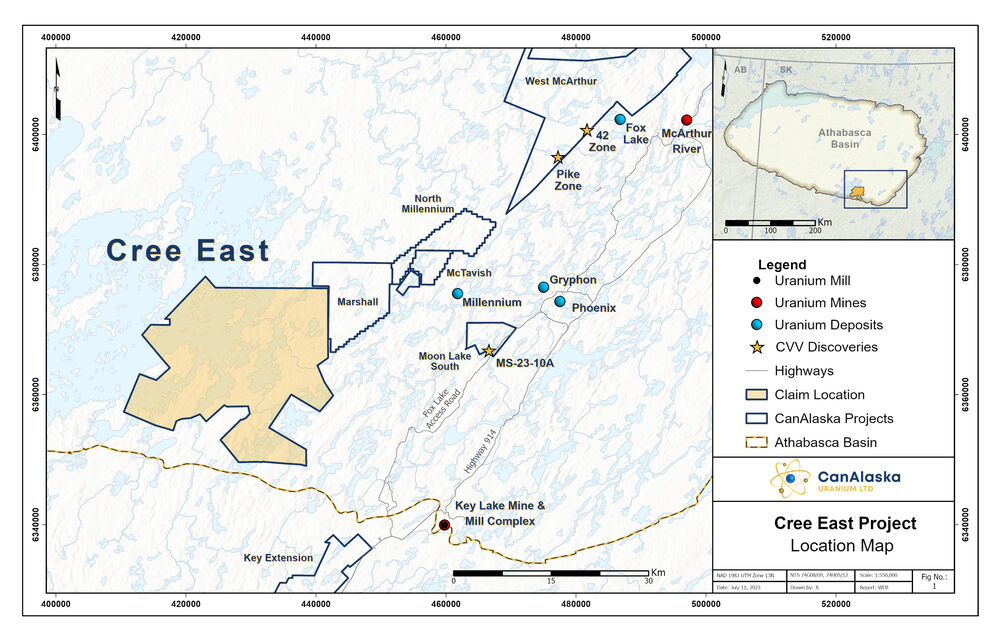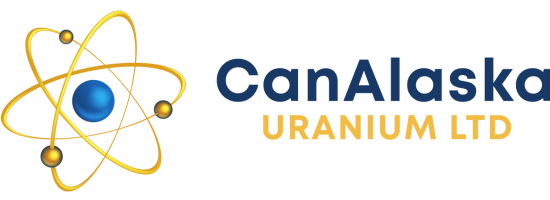Overview
- Located 35 kilometers from the Key Lake Mine
- Over 56,000 hectares land package
- Objective: a large unconformity uranium deposit
- Extensive uranium bearing systems, 9 target areas being tested
- Over $19 million invested by prior Korean partnership
- Recently completed property option agreement with Nexus Uranium for the project
Location and Ownership
The Cree East project is a high-priority property located in the south-eastern portion of the Athabasca Basin, 35 km west of the formerly producing Key Lake mine and 5 to 22 km north of the south rim of the Athabasca Basin. The project is comprised of 16 contiguous mineral claims totalling 55,935 ha.
Exploration
Due to the project’s proximity to the Key Lake mine, the area has been explored since the early 1970’s by SMDC and Uranerz among others. Most of this exploration was on the southern rim of the project area, as previous airborne geophysical surveys had limited depth penetration, and the depth to the unconformity increases to the north. Regional geochemical studies and geophysics have located numerous conductors around the southern and eastern edge of the property. Some of these conductors have been drilled, but the results were inconclusive.
CanAlaska carried out VTEM airborne surveys across the property area in 2005 and determined priority targets. In 2006, detailed collection of over 2,000 surface rock samples and over 400 lake sediment samples by CanAlaska’s field crews defined three large areas of dravite and clay alteration on surface, and localized boulder samples containing anomalous uranium. By 2007, initial ground geophysical data from the first lines of IP-Resistivity surveys, had provided the Company with evidence of strong alteration in the sandstone horizons overlying these basement conductors. Additional IP-Resistivity and Audio Magneto Telluric geophysical surveys were used to further define these targets this year. Drill programs started on the project in late February 2008 and large zones of alteration were intercepted. Extreme clay alteration and unconsolidated sands prohibited the Company from completing the majority of the winter 2008 drill holes.
During the summer of 2008, CanAlaska Uranium Ltd undertook a multi-faceted $1.6M exploration program consisting of IP/Resistivity surveying on land and high-resolution single channel seismic data collection on Cree and McIntyre Lakes, lake sediment sampling on Cree Lake, and a 5- hole diamond drilling program.
All of the drill holes reached their target depth in basement. The 2008 summer-drilling produced very positive results:
- Strong fracturing and alteration in most drill-holes
- Faulting within many of the drill-holes
- Geochemical enrichment in uranium and other elements both in the basement and in the sandstone
- Boron is distinctly anomalous in the top sandstone of all drill-holes, comparable to the results of the regional sandstone boulder sampling in this area
The winter 2009 Cree East exploration program was successful in drilling 15 holes for a total length of 6,747 metres, with only one drill-hole abandoned in bad ground near surface. All of the holes but one reached their targeted depth, and showed multiple zones of uranium and base metal enrichment, as well as basement offsets and hydrothermal alteration.
Further geophysical surveys were conducted in 2009, 2010, 2011 and 2012 to better define the drill targets on the Cree East property. The majority of the work was conducted on Grid 7. These surveys include IP/Resistivity and both SQUID Time Domain EM as well as borehole Time Domain EM.
Drilling continued on Grid 7 in 2010, 2011, and 2012, bringing the total drilled to 34,638 metres in 91 drill holes. A total of 9 target zones have been tested, all of which showed indications of hydrothermal alteration and/or uranium mineralization.
The most spectacular results were obtained on Area B, where a zone of extremely intense alteration was intersected that extend from below the unconformity at about 400m depth to near surface, with large intersections of rehealed breccia, large rotated blocks and fine pyrite impregnations. A broad arsenic geochemical halo characterizes this alteration, associated with some uranium enrichment. Horizontally this alteration zone has been observed in an area about 80 metres wide and which appears to extend 400 metres along the basement conductor.
In the 2014, a program of geophysics (DCIP, TDEM and gravity) and geochemistry (radon) was conducted to detail this area in preparation for further drilling.
Geology
The project area covers Athabasca Group conglomerates and sandstones. Sandstone unconformably overlies basement at depths in the order of 200 to 300 metres in the south. Structural breaks which trend across the across the property further drop the basement to estimated depths of 700 to 800 metres across the northern edge of the property. The basement is composed mainly of the Lower Proterozoic, (Trans Hudson) Mudjatik domain, with granitoids and associated minor supracrustal rocks (psammites, pelites and metavolcanics). A significant portion of the property is underlain by rocks of the highly prospective Wollaston Domain.
Potential
This project is has potential for the discovery of high grade unconformity style Uranium mineralization either basement-hosted like McArthur River or Arrow or sandstone-hosted like Cigar Lake. The area has numerous conductors and faults which act as both the conduit and the trap for potential Uranium mineralization. A number of structures and conductive targets have been identified from the Company’s exploration efforts.
Project Technical Report
- The Qualified Person for this overview was Peter Dasler at the time of publication. More detailed exploration information is available in the attached exploration news releases


